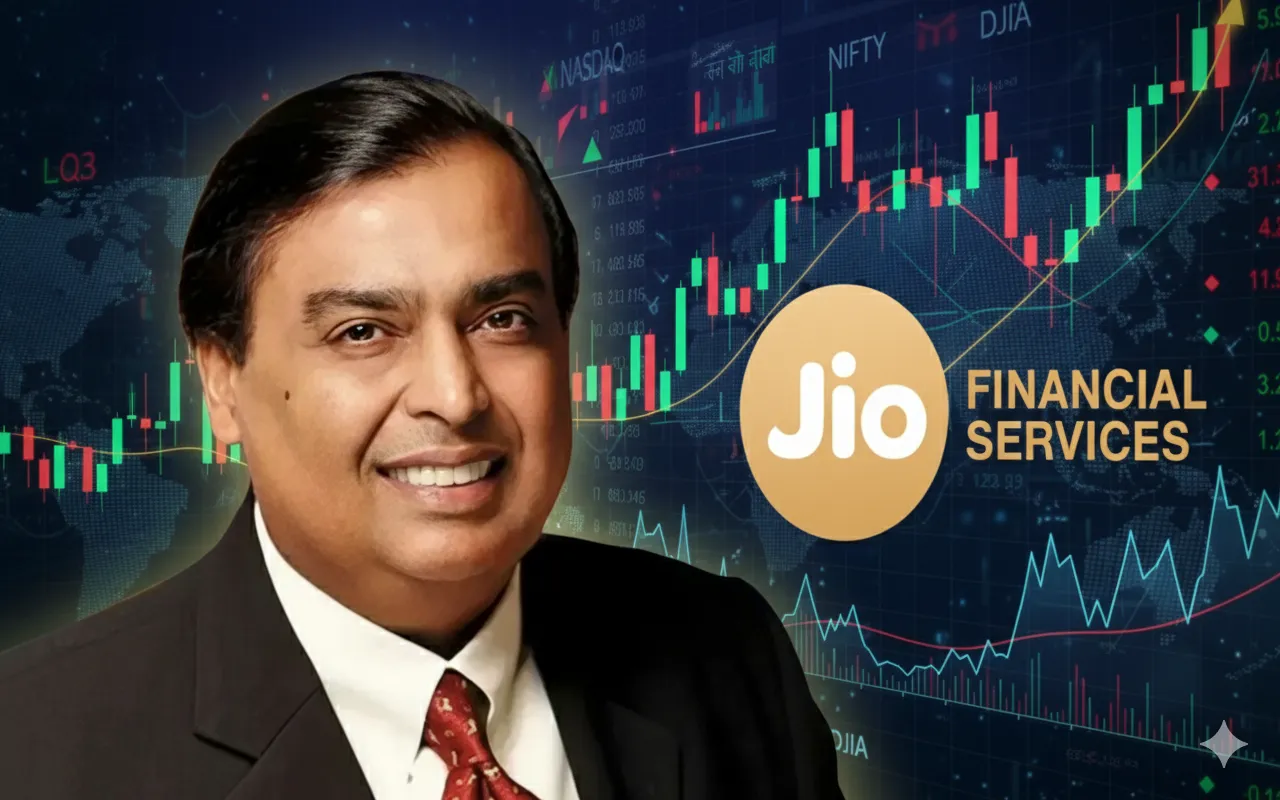Jio Financial Services (JIOFIN) has been a hot topic among investors in 2025, thanks to its mixed performance and the growing influence of its powerful promoter group. The stock currently trades around ₹310, with most analysts setting a 1-year target near ₹325, while some optimistic projections stretch up to ₹350—reflecting expectations of steady growth ahead.
Although the company has seen some ups and downs—like uneven quarterly earnings and slight drops in net profit—technical indicators such as MACD and EMA crossovers suggest that the stock is currently in a consolidation phase. Still, strong backing from promoter infusions, rising institutional interest, and continued expansion in its digital lending and payments segments are giving investors confidence in its long-term potential.
In this article, we’ll take a closer look at Jio Financial’s fundamentals, recent performance, and expert share price forecasts—spanning from 2025 all the way to 2050—to help you understand whether this stock could be a solid bet for the future.
About the Company
Jio Financial Services Limited (JFSL) is part of the Reliance / Jio ecosystem, positioned as a diversified financial services entity.
Some key points:
- Originally part of Reliance, Jio Financial was spun off and listed in 2023.
- It operates across digital lending, payments, broking, asset management (via the Jio-BlackRock JV), and NBFC / financial services verticals.
- It has full control of Jio Payments Bank after acquiring SBI’s stake in 2025, which strengthens its payments / transactional infrastructure.
- It recently got SEBI approvals for broking via Jio-BlackRock Broking and for mutual fund business via Jio-BlackRock AMCs.
- The promoter group (Ambani / Reliance) has infused capital (₹15,825 crore via preferential convertible warrants) to raise promoter stake above 54% from ~47%.
These structural moves reflect the company’s ambition to be a full-stack financial services player in India’s digital era.
Fundamental Analysis
Revenue & Profit Trends
- In Q1 FY26, Jio Financial posted consolidated net profit of ₹325 crore, up 3.8% YoY, and revenue from operations jumped ~47% YoY.
- Over recent years, the company has shown explosive growth in topline and operating profits (CAGR > 400%+ in some periods), though earnings have been volatile.
- The TTM revenue is about ₹2,238 crore and operating profit ~ ₹1,661 crore as per your data input.
- EPS is around ₹2.55 (your figure), with a dividend payout ratio near 20%.
While the growth metrics are strong, the recent quarters show flattening or dips in PAT because base effects, provisioning, or interest components may weigh.
Valuation Metrics (P/E, ROE, EPS)
- JIOFIN’s P/E ratio is very lofty. In FY25 / TTM estimates, some reports quote ~130x P/E on recent earnings.
- According to the Economic Times, the PE is ~117.34 ×.
- EPS (TTM) is ~ ₹2.56 per share.
- ROE is harder to pin down consistently given high fluctuations and capital raising; the growth is coming more from scale than consistent margin expansion in early stages.
Balance Sheet Strength
- On the balance sheet, equity capital is about ₹6,353 crore (per your input) and reserves are ₹1,17,143 crore — showing a strong buffer.
- Debt / liabilities remain manageable.
- Cash & equivalents rose from ~ ₹67 crore to ~ ₹352 crore (per your input), showing liquidity improvement.
- Operating cash flows turned negative in FY25, but investing and financing flows were positive — reflecting capital investments & fundraisings.
Shareholding Pattern
| Category | Share (%) |
|---|---|
| Promoter / Promoter Group | ~54% (after capital infusion) |
| Institutional Investors (FIIs / DIIs) | ~27.17% (your data) |
| Public & Others | Remaining ~18–20% |
A strong promoter stake, along with healthy institutional holding, lends credibility and stability in volatile phases.
Past Stock Performance
- JIOFIN has underperformed broader indices in the recent 12 months (return ~ –7.77%, per your input).
- The 52-week range: ₹198.65 (low) to ₹363.00 (high).
- The stock surged ~13% in one week to ₹331.40, reflecting episodic momentum bursts.
- But volatility remains high due to earnings fluctuations, shifting analyst views, and valuation pressures.
Jio Financial Services Share Price Target for 2025 – 2050
| Year | Minimum (₹) | Average (₹) | Maximum (₹) |
|---|---|---|---|
| 2025 | 285 | 315 | 350 |
| 2026 | 310 | 350 | 390 |
| 2027 | 340 | 390 | 440 |
| 2028 | 370 | 430 | 500 |
| 2029 | 410 | 480 | 560 |
| 2030 | 460 | 540 | 630 |
| 2035 | 800 | 950 | 1,150 |
| 2040 | 1,400 | 1,700 | 2,100 |
| 2045 | 2,300 | 2,900 | 3,600 |
| 2050 | 3,700 | 4,500 | 5,800 |
Note: These are speculative ranges based on assumed CAGR growth of ~15–20% over long term, structural expansion into broking, payments, asset management, and strong promoter backing.
Year-Wise Target Explanation & Assumptions
- 2025: Analysts’ consensus target is ~₹325 (some short-term views suggesting ₹340–₹350).
- 2026–2030: As Jio Financial scales its lending, payments, broking, and mutual fund businesses, we assume 15–18% CAGR in earnings, multiple expansion from current high valuations toward more justified levels.
- 2035–2050: The stock may benefit from compounding, broader adoption of digital finance in India, potential monetization of device leasing (as per plans) and capital light models, helping push valuations into multibagger territory.
Growth Drivers
- Integration with Jio / Reliance ecosystem: The access to a massive user base, distribution, and synergy helps cross-sell financial products.
- Full ownership of Jio Payments Bank: Enables transactional backbone, lowering dependence on third-party platforms.
- JV with BlackRock: Access to global asset management technology, credibility, and scale in mutual funds / wealth.
- Broking & advisory verticals: New SEBI approvals open revenue streams.
- Capital infusion & promoter confidence: The ₹15,825 crore infusion will bolster balance sheet and guide expansion.
- Device-leasing initiative: Plans to lease telecom / computing devices via Jio’s reach may open a non-traditional revenue line.
Expert Views & Recent Moves
- Choice Broking / Sumeet Bagadia: Suggests short-term target of ₹340–₹350, with stop loss at ₹300.
- Bonanza / Nitin Jain: Prior to Q1 results, positive views on segmental income growth and technicals.
- Market commentary: Following SEBI approvals for broking, mutual funds, full control of payments bank, the stock rose ~3–4%.
- Analyst consensus: Some platforms show average target ~₹272, implying downside from current levels.
- Reuters / news: Promoter infusion of ₹15,825 crore is seen as a strong show of confidence.
Risks & Challenges
- Very high valuation relative to earnings; downside corrections are possible.
- Execution risk in scaling new verticals (mutual funds, broking, device leasing)
- Macro / regulatory risks in financial & NBFC sector
- Negative surprises in provisioning, interest cost, or credit losses
- Over-dependence on promoter capital injections if internal cash flows remain weak
Investment Suitability
- Long-term growth investors willing to ride volatility and back a digital financial play
- Moderate-risk takers who understand financials & sector cycles
- Growth / small-cap portfolio diversifiers seeking exposure to fintech / NBFC disruption
Avoid if you need stable income or low volatility; JIOFIN is more of a structural, growth bet than a defensive dividend play.
FAQs
What will be Jio Financial’s share price in 2030?
Based on our projections, JIOFIN could range between ₹460 and ₹630, with an average expectation ~₹540.
Can JIOFIN reach ₹350 by 2025?
Yes — many analysts already target ₹340–₹350 for the near term, contingent on positive execution and momentum.
Is JIOFIN good for long-term investment?
It has potential as a long-term growth bet if you believe in India’s fintech / digital finance growth and trust the promoter execution. But risks are high, and earnings are volatile.
Conclusion
Jio Financial Services sits at the intersection of ambition, promoter support, and structural opportunity in India’s financial sector. The stock currently trades near ₹310, with many analysts pointing toward ₹325–₹350 in the near term, subject to execution on new verticals and stable earnings.
Over a 10- to 20-year horizon, the company has the potential to deliver multibagger returns if it scales its payments, asset management, lending, and device-leasing ambitions successfully. That said, lofty valuations, execution risk, and volatility remain key challenges.
For long-term investors with higher risk tolerance, JIOFIN is worth keeping on the radar — but prudent position sizing, periodic review, and patience will be crucial.




